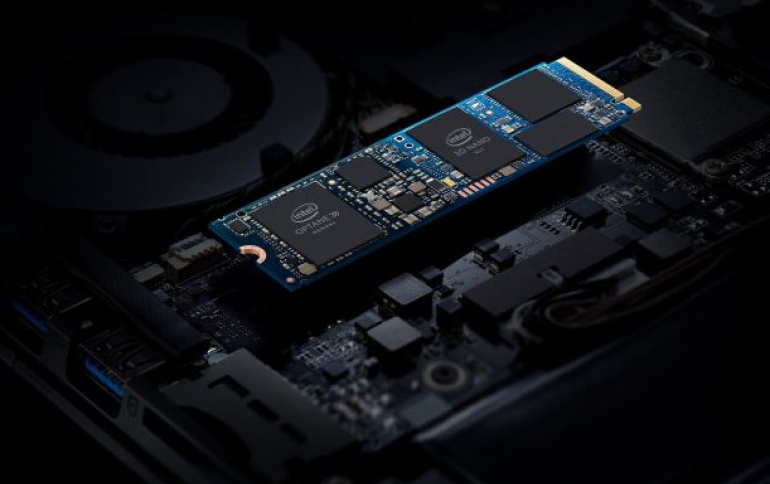
Intel Optane Memory H10 Drive Packs Optane Technology and Intel QLC NAND
Intel today introduced Intel Optane memory H10 with solid-state storage.
The device combines the responsiveness of Intel Optane technology with the storage capacity of Intel Quad Level Cell (QLC) 3D NAND technology in an M.2 form factor. It enables Intel Optane memory expansion into thin notebooks and certain space-constrained desktop form factors – such as all-in-one PCs and mini PCs.
Intel claims that the Optane Memory H10 offers a higher level of performance not met by traditional Triple Level Cell (TLC) 3D NAND SSDs today and eliminates the need for a secondary storage device. The device enables both faster access to frequently used applications and files and better responsiveness with background activity.
The Optane Memory H10 drive is an OEM product, and will be found in upcoming 8th Generation Intel Core U-series mobile platforms starting from this quarter (Dell, HP, ASUS, Acer and others.)
While multitasking, these new platforms will launch documents up to 2 times faster; launch games 60% faster; and open media files up to 90% faster, according to Intel.
The Intel Optane memory H10 with solid-state storage will come in the following capacities, 16GB (Intel Optane memory) + 256GB (storage); 32GB (Intel Optane memory) + 512GB (storage); and 32GB (Intel Optane memory) + 1TB storage.
Intel claims that the Optane H10 will offer sequential read speeds of up to 2,400MBps and sequential write speeds of up to 1,800MBps. That's much faster than what you'll see from Serial ATA-based SSDs, but it is still short of the peak sequential speeds that the most capable consumer SSDs on the market can achieve. The Optane H10 will also offer up to 32,000 IOPS of random read performance (when the drive is handling a single request at a time), and up to 30,000 IOPS of random write performance.
The Optane H10 modules will also consume less than 15 milliwatts of power at idle.
| Intel Optane Memory H10 with Solid State Storage (32GB + 1TB, M.2 80mm PCIe 3.0, 3D XPoint, QLC) | Intel Optane Memory H10 with Solid State Storage (32GB + 512GB, M.2 80mm PCIe 3.0, 3D XPoint, QLC) | Intel Optane Memory H10 with Solid State Storage (16GB + 256GB, M.2 80mm PCIe 3.0, 3D XPoint, QLC) | |
| Capacity | 1 TB |
512 GB |
256 GB |
| Sequential Read (up to) | 2400 MB/s |
2300 MB/s |
1450 MB/s |
| Sequential Write (up to) | 1800 MB/s |
1300 MB/s |
650 MB/s |
| Random Read (8GB Span) (up to) | 330000 IOPS |
320000 IOPS |
230000 IOPS |
| Random Write (8GB Span) (up to) | 250000 IOPS |
150000 IOPS |
|
| Latency - Read | 7 µs |
8 µs |
|
| Latency - Write | 18 µs |
18 µs |
30 µs |
| Power - Active | 5.8W |
5.3W |
|
| Power - Idle | L1.2 : <13mW |
L1.2 : <12mW |
|
| Vibration - Operating | 2.17 GRMS (5-700 Hz) Max |
||
| Vibration - Non-Operating | 3.13 GRMS (5-800 Hz) Max |
||
| Shock (Operating and Non-Operating) | 1000 G / 0.5 ms and 1500 G / 0.5 ms |
||
| Operating Temperature Range | 0°C to 70°C |
||
| Endurance Rating (Lifetime Writes) | 300 TBW |
150 TBW |
75TBW |
| Mean Time Between Failures (MTBF) | 1.6 Million Hours |
||
| Uncorrectable Bit Error Rate (UBER) | < 1 sector per 10^15 bits read |
||
| Warranty Period | 5 yrs |
||
| Weight | Less than 10 grams |
||
| Form Factor | M.2 22 x 80mm |
||
| Interface | PCIe NVMe 3.0 x4 |
||
| Operating System Support | Windows 10 64 bit |
||
| Supported Platforms | 8th Gen and 9th Gen or newer Intel Core processor-based platforms |
||
| Software Driver | Intel Rapid Storage Technology (Intel RST) Driver 17.2 or later |
||
| Enhanced Power Loss Data Protection | Yes |
||
| Temperature Monitoring and Logging | |||
| End-to-End Data Protection | |||
| Intel Rapid Start Technology | |||





















